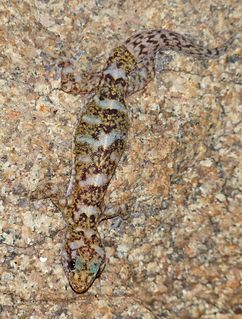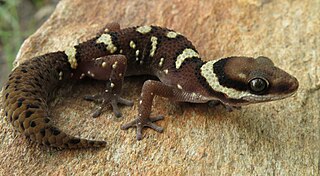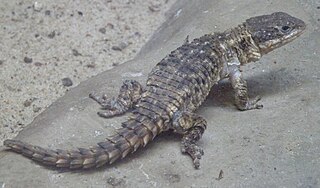
Cordylidae is a family of small to medium-sized lizards that occur in southern and eastern Africa. They are commonly known as girdled lizards, spinytail lizards, or girdle-tail lizards.

Afroedura is a genus of African geckos, lizards in the family Gekkonidae. Member species are collectively known as rock geckos or flat geckos.

Pachydactylus is a genus of insectivorous geckos, lizards in the family Gekkonidae. The genus is endemic to Africa, and member species are commonly known as thick-toed geckos. The genus also displays rich speciation, having 57 distinct species identified when compared to other closely related gecko genera like Rhoptropus, most of which have emerged since 35Ma. It has been suggested that the reason for this rich speciation not from adaptive radiation nor nonadaptive radiation, but that the genus represents a clade somewhere between the two drivers of speciation. P. bibronii geckos have been used by NASA as animal models for experimentation.

The genus Cordylus includes a wide variety of small- to medium-sized spiny lizards from Africa, collectively called girdle-tailed or girdled lizards. All are diurnal and ovoviviparous. Most species are rupicolous (rock-dwelling), while a few species are arboreal or live in burrows. They defend themselves with osteoderms and by quickly retreating into rock crevices or burrows. Many species live in groups and males defend territories.

Platysaurus is a genus of lizards, commonly known as flat lizards for their flat backs, in the family Cordylidae.

Pseudocordylus is a genus of small to large girdled lizards from South Africa, commonly known as crag lizards. Six species of Pseudocordylus are known; they are distinguished from girdled lizards of the genus Cordylus by the presence of granular scales on the back instead of osteoderms.
Acontias is a genus of limbless skinks, the lance skinks, in the African subfamily Acontinae. Most are small animals, but the largest member of the genus is Acontias plumbeus at approximately 40 cm (16 in) snout-vent length. All members of this genus are live-bearing sandswimmers, with fused eyelids. A recent review moved species that were formerly placed in the genera Typhlosaurus, Acontophiops, and Microacontias into this genus, as together these form a single branch in the tree of life. This new concept of Acontias is a sister lineage to Typhlosaurus, and these two genera are the only genera within the subfamily Acontinae.
Lawrence's girdled lizard is a species of lizard in the family Cordylidae. The species is endemic to South Africa.

The Sekukhune flat lizard is a species of lizard in the family Cordylidae. The species is endemic to South Africa. It has two subspecies.

The Limpopo girdled lizard, also known commonly as Jones's armadillo lizard and Jones's girdled lizard, is a species of lizard in the family Cordylidae. The species is endemic to Southern Africa.

Warren's girdled lizard is a species of relatively large, flattened lizard in the family Cordylidae. The species is native to Southern Africa.
Vivian Frederick Maynard FitzSimons, born in Pietermaritzburg, was a notable herpetologist in South Africa. Also, he contributed to the collection of spermatophyte samples for the National Herbarium which has become part of the South African National Biodiversity Institute at the Pretoria National Botanical Garden. In 1937, together with Anna Amelia Obermeyer, he collected some of the earliest plant specimens from the Eastern Highlands of Rhodesia.
Namazonurus campbelli, commonly known as Campbell's girdled lizard, is a species of lizard in the family Cordylidae. A small girdled lizard, N. campbelli is endemic to Namibia. It is often mistaken for the more common Herero girdled lizard, N. pustulatus, as they both are similar in size and have flattened bodies. N. campbelli lives in rock crevices and cracks on dry mountain slopes

Smaug is a genus of lizards in the family Cordylidae. The genus Smaug is a group of species of spiny southern African lizards, separated from the genus Cordylus in 2011 on the basis of a comprehensive molecular phylogeny of the Cordylidae. The type species is the giant girdled lizard, S. giganteus.

Van Dam's girdled lizard is a species of lizard in the family Cordylidae. The species is endemic to South Africa.

Karusasaurus, commonly known as Karusa lizards, is a genus of lizards in the family Cordylidae.

Karusasaurus polyzonus, commonly known as the Karoo girdled lizard or the Southern karusa lizard, is a species of lizard in the family Cordylidae.
The Namaqua girdled lizard is a species of lizard in the family Cordylidae. It is a small, spiny lizard found in Namibia and South Africa.

Peers’s girdled lizard or Peers’s Nama lizard is a species of lizard in the family Cordylidae. It is a small, spiny lizard found in South Africa.
The Herero girdled lizard is a species of lizard in the family Cordylidae. It is a small, spiny lizard found in Namibia.












